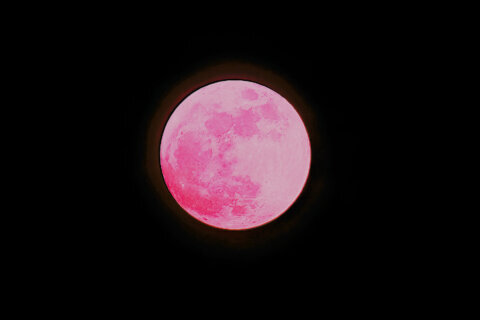Editor’s note: A G3 (strong) to G4 (severe) level geomagnetic storm is ongoing since early Sunday. The Space Weather Prediction Center’s most recent forecast (8:30 a.m. Eastern) is that these conditions will continue Sunday night through Monday morning.
Just over a year ago, on May 10, 2024, the aurora borealis lit up the skies worldwide due to an extreme geomagnetic storm. The D.C. region had several glorious nights of the northern lights in 2024.
The last aurora alert for the region was in April. But over the next few nights, with the sun having had several significant events in the past day, the prospects of seeing the dazzling lights are far greater, with Earth directly in the crosshairs to receive significant effects as a result.
The National Oceanic and Atmospheric Administration Space Weather Prediction Center issued the following Geomagnetic Storm Alert Saturday at 10:04 a.m. EDT:
Geomagnetic Storm Category G4 or Greater Predicted
Highest Storm Level Predicted by Day:
Jun 01: G3 (Strong) Jun 02: G4 (Severe) Jun 03: G2 (Moderate)
As stated in the alert:
- Potential Impacts: Area of impact primarily poleward of 45 degrees geomagnetic latitude.
- Induced Currents: Possible widespread voltage control problems and some protective systems may mistakenly trip out key assets from the power grid. Induced pipeline currents intensify.
- Spacecraft: Systems may experience surface charging; increased drag on low earth orbit satellites, and tracking and orientation problems may occur.
- Navigation: GPS degraded or inoperable for hours.
- Radio: High frequency radio propagation sporadic or blacked out.
- Aurora: Aurora may be seen as low as Alabama and northern California.
This geomagnetic storm watch is in effect due to a large coronal mass ejection caused by a powerful solar flare, which occurred over the past day on the sun which was caused by a powerful solar flare, according to the Space Weather Prediction Center. There have been 11 solar flares, including one very powerful outburst, in a 24-hour period.
This geomagnetic storm and associated aurora event forecast is not predicted to reach the historic levels of May 10, 2024. But we should be watching the skies because if the forecast holds for G4 (Severe), it could be quite the sight.
The latest SWPC forecast states a G4 or severe geomagnetic storm watch is in effect for Monday, June 2, but lights is anticipated to arrive on Earth no later than Sunday, June 1.
“The CME arrival will likely lead to immediate geomagnetic disturbances with the potential for G3 (Strong) levels, and a chance for G4. Conditions will likely intensify as CME progression continues and G4 levels become more possible on Monday, 2 June,” SWPC said.
For the D.C. area, SWPC’s two-day aurora forecast and the forecast clear skies mean lights may be detected to the North.
If the SWPC forecast holds, aurora conditions may be strong enough over the next few nights to allow us to detect aurora visually and with our cameras, like we did in October.
It will be well worth taking a look to the north over the next few nights from a dark sky site with a clear horizon. You might be able to visually detect some color in the sky if aurora are present, but they will likely be low on the northern horizon. In October, the aurora were spread along the northern horizon and spectacularly high in the sky.
Your camera and/or smartphone significantly improves your chances of detecting and imaging the aurora due to their digital sensors.
Use a camera or smartphone that can take exposures of several seconds. Use “night sky” or “low light” settings if your camera has them. Steady the camera, or use a tripod to prevent blurriness in your photos. The camera likely capture aurora that your eyes did not.
Monitor WTOP’s weather page for sky conditions, the NOAA website, EarthSky.org, SpaceWeather.com and space.com for updates.
Space weather explained
Terrestrial weather is a factor in the D.C. region and the rest of the world, as well as space weather. Space weather can produce a variety of events, including this most recent geomagnetic storm and the aurora.
Space weather, like terrestrial weather, is caused by Earth’s interaction with the sun. We know it will be there every new day and count on it for life-giving warmth and energy. We also have become accustomed to it being well-behaved. What many people may not know is that the sun undergoes an 11-year solar cycle that can affect space weather throughout our solar system.
The sun is a 4.5 billion-year-old star that we have been monitoring for millennia. There is a fleet of spacecraft that monitor the sun and space weather 24 hours per day, seven days a week, 365 days per year.
The sun had an episode of disturbed behavior in 1859 that if it were to occur today could adversely affect us if we were not prepared.
On Sept. 1, 1859, the sun experienced a solar storm episode that was observed by solar astronomer Richard Carrington and ended up bearing his name — the Carrington Event. This was a watershed event in solar astronomy. It had an effect on the Earth like nothing we have seen since.
And that’s a good thing. If a Carrington-level solar event were to happen today, the effect on modern infrastructure could be potentially catastrophic — especially the electrical grid. If you think this is too “sci-fi” to be true, I suggest you read the report by the National Academies of Science published in 2008.
Follow Greg Redfern on Facebook, Bluesky and his daily blog to keep up with the latest news in astronomy and space exploration.
Get breaking news and daily headlines delivered to your email inbox by signing up here.
© 2025 WTOP. All Rights Reserved. This website is not intended for users located within the European Economic Area.






